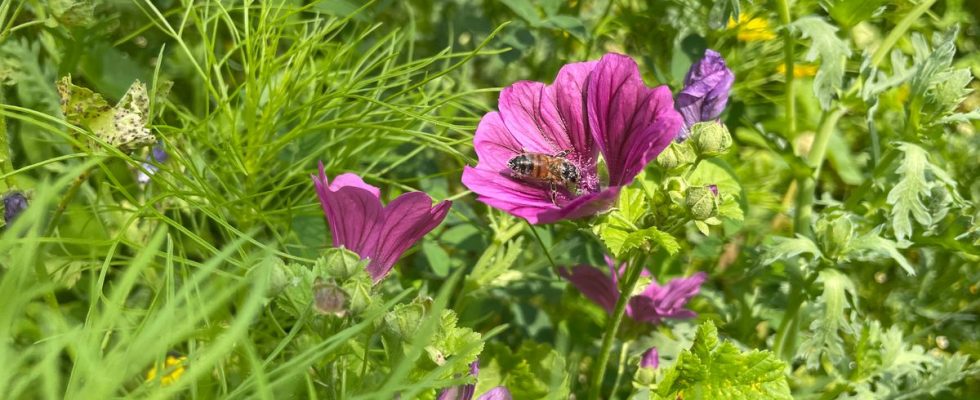Bees, ants, wasps, flies, mosquitoes, butterflies… These pollinating insects are vital to our environment, our agriculture and therefore our way of life. “If these insects disappear tomorrow, 30% of our plate goes with it,” warns Amélie Delerue, in charge of the LIFE project for the preservation of wild bees in the Médoc regional park (Gironde). Due to human activity, industrialization, past or current massive use of pesticides, urban planning or the introduction of invasive species, the number of pollinators is falling sharply. According to the Natural History Museumin some places, this reduction is of the order of 70% to 90%.
To remedy this problem, two initiatives were launched this Monday and Tuesday in Gironde to try to repopulate and identify these bees and insects.
Take pictures for science
In Bordeaux, no study lists for the moment the evolution of the number of pollinators. Teams from INRAE*, the University of Bordeaux and CNRS presented this Tuesday the first regional version of the national participatory project SPIpoll (Photographic Monitoring of Pollinating Insects). The objective is simple: to better understand the diversity and location of these insect populations in order to be able to ultimately “to establish the roles of these elements on the territory of Bordeaux Métropole and to propose objective recommendations in support of public policies”, explains Frédéric Revers, one of the researchers of the study.
But this task is far too heavy for a team of three people. These researchers therefore ask the inhabitants of the metropolis to help them by photographing the insects. For this, the volunteers will have to stand for twenty minutes in front of a flower bed and photograph the pollinators in action. The photos taken must be sent to the Spipoll site or application.
“Photographs can even be taken from a balcony”
“And no need to have any special skills, the application recognizes the type of flowers and you identify the insects thanks to a nomenclature”, explains the scientist. As for the choice of location, the photographer is free. “Photographs can even be taken from a balcony,” adds Frédéric Revers.
And when is the best time to shoot? “The best is when the temperatures are between 15 and 25 degrees and there is not too much wind,” he replies. As for the time of year, pollinators are mostly out between March and October.
Thanks to the geolocation of the photos, the researchers hope to be able to present an accurate and scientifically validated map of pollinators within three to five years. The issue of saving these insects is crucial, recalls Frédéric Revers, citing in particular an investigation by the scientific journal Environmental Health Perspectivesin which we learn that worldwide, half a million people die prematurely each year due to the decline of these species.
Reseed grasslands
Stretching from the tip of Verdon-sur-Mer to the Bordeaux metropolis, the Médoc regional park is home to a large biodiversity. But the decline of wild bees is also worrying there and has led Amélie Delerue and her teams to work to restore a habitat favorable to the arrival of these insects, which are sometimes smaller than a grain of rice. “In the north of the Médoc, we have identified so-called degraded areas on former plots of corn and wheat cultivation, explains the manager, with very poor vegetation, made up of four to five species of flowers. For these meadows to be colorful and flowery again, without the action of man, it would take decades. But urgency calls for quick action. So, to solve the diversity problem, the LIFE project teams decided to reseed the grasslands.
“But in the seed trade, you mainly find ready-made seed mixtures, especially useful for making hay. These are mixtures that are poor in diversity and not at all suitable for pollinators,” explains Amélie Delerue. The technicians therefore launched this Monday a seed brushing operation in the neighboring Medoc meadows. The seeds collected will be reseeded in the fall on the prairies undergoing agricultural transition.
“In France, we have 1,000 species of wild bees. All are important for pollinating all floral biodiversity. They all have very specific eating habits and all play a role. Take for example the collar of the ivy. This wild bee only forages on ivy. So if there is no more ivy, there is no more ivy crown, and vice versa,” insists the project manager.
To preserve pollinators, INRAE researchers recommend, among other things, increasing floral resources, restoring natural environments, reducing (or even banishing) pesticides, reducing the density of honeybee hives ( which compete with wild species) and finally not to install insect hotels, vectors of diseases for these small animals.
* National Research Institute for Agriculture, Food and the Environment

